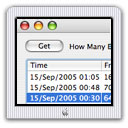
|
MailServe Snow MailServe for Snow Leopard now includes a fresh 32/64-bit build of Dovecot. While UW/IMAP is still available as an IMAP/POP3 option, the focus is now on Dovecot and what we can build on it. For a start, we now have a high-performance, more fault-tolerant server that supports a multi-level hierarchy of IMAP folders. Then it allows us to do some things more easily than before, like setting up a spam filter based on Procmail and SpamBayes with just one click. Plus some of the many things that we've built over the years into MailServe, which have all gotten little tweaks to improve their usefulness - e.g., you can add custom settings to just about everything MailServe handles, e.g., to Fetchmail, Dovecot and Procmail. And you can now manage the mail user accounts from right within MailServe. Also, SSL certificate handling is now improved with a more streamlined interface, so you can share certificates with the web server (if you use WebMon to set up the web server).
|
Please download MailServe Snow only after buying a serial number. The serial number & download link will be displayed in the browser after payment, and will also be sent via email.
|
|||
|
Check out the MailServe for Snow Leopard Owner's Manual
|
New Features Dovecot This is the Dovecot panel, which allows you to choose which Dovecot services, including their SSL variants, to turn on. It also allows you to set which port numbers are to be used for each service. If left blank, the default ports will be used. For Snow Leopard, you can now specify custom Dovecot config settings.
Why is Dovecot so good? Dovecot is very fast and stable. It allows multiple levels of IMAP folders. And it's more easily configurable so it presents some real possibilities to improve the system. This is how Mail.app looks when working with an IMAP server that supports hierarchical folders :
UW/IMAP UW/IMAP is still supported. Its toolbar button is hidden but can be retrieved from the Customize Toolbar menu.
But I'm planning to build more things on top of Dovecot, Procmail and Postfix, so UW/IMAP will fade in importance. If you need to run both Dovecot and UW/IMAP at the same time For your convenience, if you start Dovecot while UW/IMAP is on, MailServe will turn off UW/IMAP automatically before turning on Dovecot. This also works the other way round. If Dovecot is running and you Start UW/IMAP, MailServe will close down Dovecot first before starting UW/IMAP. There is one exception and this is to help users run both Dovecot and UW/IMAP at the same time in order to transfer mailboxes from UW/IMAP to Dovecot. If you set Dovecot to use ports other than the default, you can have Dovecot running and still have the ability to force-start UW/IMAP, which will use the default ports. You do this by holding down the Shift-Key when you Start UW/IMAP while Dovecot is running. But you must have Dovecot running on the non-default ports. You can always set Dovecot back to the default ports after you have transferred over all you mailboxes to Dovecot and don't need UW/IMAP anymore, in which case you should Stop UW/IMAP, set Dovecot back to the default ports and Restart Dovecot. Note: If you're using Mail.app, you can connect to the same server on two different IMAP ports by accessing one connection via its domain name (for, say, UW/IMAP), and then creating another account (for Dovecot) and accessing the server via its IP address (this time connecting to the custom port you set for Dovecot). When both accounts are active in Mail.app, you can drag the folders from UW/IMAP to Dovecot. Tech Notes Dovecot's IMAP folders on the server are stored in each user's ~/Mail folder. The Inbox is also stored in the ~/Mail folder. UW/IMAP's folders are in each user's ~/Library/Mail/IMAP folder. And its Inbox is in /var/mail. Other Improvements to MailServe for Snow Leopard SSL Certificate Management There's an improved user interface for handling existing SSL certs, as opposed to a test cert, and MailServe will be able to detect if SSL can be turned on for the mail server if the required type of cert is available :
MailServe Snow can help the user generate a certificate request to a Cert Authority and pair the returned cert with its matching private key from right inside MailServe:
If you have a web server managed by WebMon, on Snow Leopard you can now more easily share the use of the certificate between mail and web servers. MailServe Snow and WebMon Snow create test certs and cert requests with 2048 bit length keys. Fetchmail Custom settings. This is the most requested feature. You can specify Fetchmail Server and User options separately:
Spam Filtering and Mail User Accounts Management MailServe Snow can now do spam filtering with just one click :
It uses SpamBayes, which occupies a smaller footprint than spamassassin and yet is just as effective. This is our first iteration for spam filtering support, so it can possibly be made even better in future releases. Please note that MailServe Snow's spam fltering mechanism needs Dovecot to be running. It also uses Procmail to integrate Postfix, Dovecot and SpamBayes. With version 4.1.4 of MailServe Snow, there is now a Procmail button in the Spam Panel, above, that'll allow the user to set up custom Procmail directives to be processed before or after spam filtering. The user can also edit the default procmailrc directives, with the option to revert to default if the custom edits do not work. The Spam panel now also contains a Mail User Management utility, which allows the administrator to create and delete mail users, decide if they are to be standard OS X users, or users with a minimal home folder (to store the IMAP folders) and who are hidden from the OS X Login Window. The administrator can also decide for each user if his spam mail will be deleted right away or continue to be collected in the spam folder. The MailServe Snow Manual For new users to MailServe, there is a step-by-step guide to setting up a mail server and it can be found here. 4.1 30th August 2009. MailServe for Snow Leopard released. 4.1.1 7th September 2009. Minor tweaks and bug fixes. 4.1.2 26th September 2009. Patched a problem with a mis-configured pam_config file that could compromise POP and IMAP security. 4.1.3 29th January 2010. Added the ability to create and delete mail users from within MailServe, and decide if the user should be hidden from the Login Window and whether he has the full complement of the standard OS X home folder or a minimal home folder to store only the IMAP folders. The administrator can also decide for this user if his spam mail will be deleted right away or continue to collected in the spam folder. Dovecot has been updated to the latest version 1.2.10. Fetchmail was updated by Apple to 6.3.11 via the latest software updates, and this version has a much less chatty log and so the Fetchmail log has been merged with the Postfix and Dovecot log in the MailServe Log Panel. Finally, there used to be a 16K limit to the size of the Aliases field (and all other similar fields). This limit has been removed and they can now contain as much information as the mail admin wants. 4.1.4 6th March 2010. MailServe Snow now creates SSL test certs and cert requests at 2048 bits. Also, MailServe Snow uses Procmail to integrate Postfix, Dovecot and SpamBayes to implement spam filtering. With version 4.1.4, there is a now a new feature for setting up custom Procmail directives that will be processed before or after the default procmailrc set up for spam filtering. The default procmailrc can also be edited and there's a button to revert the directives back to their default state if, for some reason, the custom edits don't work. 4.1.5 5th April 2010. This is a minor user preferences update. If you have both a test SSL cert, as well as a "real" cert from a Certification Authority installed, MailServe will now "remember" which version the user prefers to use, rather than default to the use of the test cert if the user didn't choose the use of the real cert explicitly. |
||||
| DNS Enabler for Snow Leopard, when setting up a secondary name server, can now automatically display the updates to the secondary name server when the zone information in the primary name server changes. It can now also create CNAME records for the managed domain that point to an external host like Google.com. And it can set up multiple MX records pointing to an external host that is acting as the mail server for the hosts in the managed domain.
WebMon for Snow Leopard can now set up multiple virtual domains in addition to the main domain. The SSL cert management feature has been improved and WebMon can now share SSL certs with MailServe, so the mail server and web server both use the same certs. The new WebMon also sets up server-side includes and execCGI for the web server so that developers can have an even richer platform for web software development. Plus something that has been asked for : the ability to add custom Apache directives to the ones WebMon builds. |
|||||












